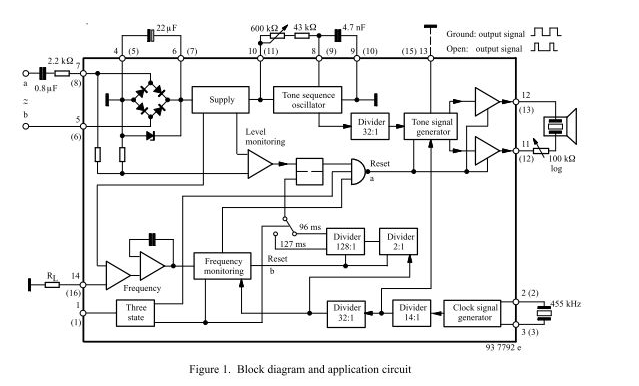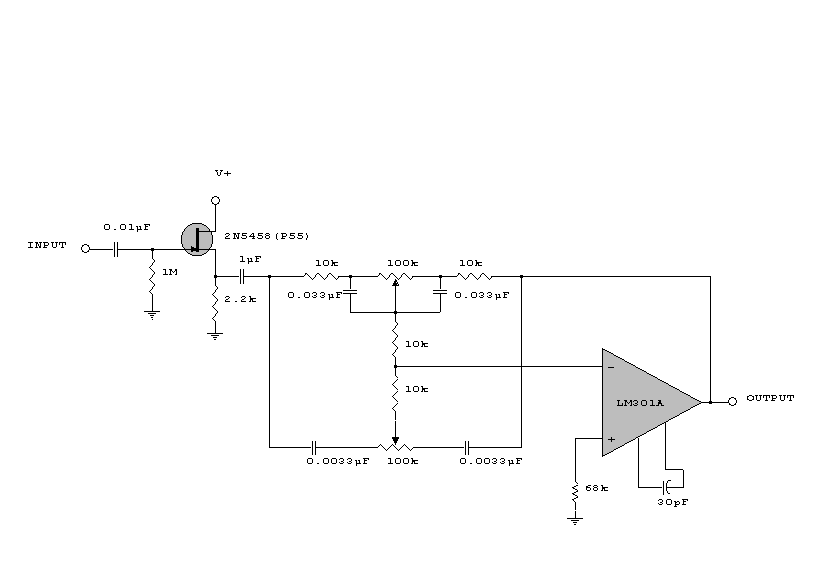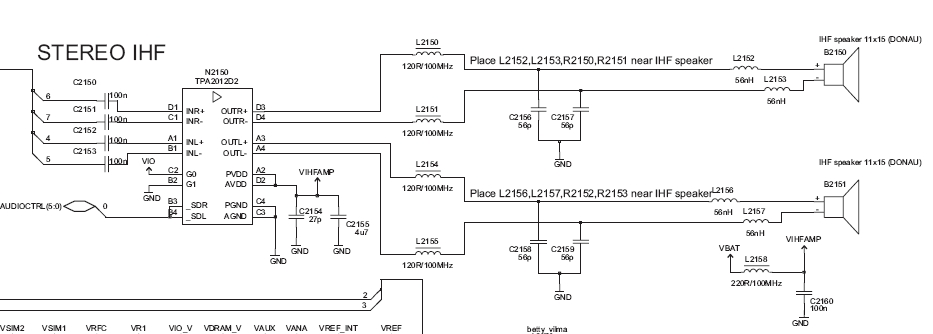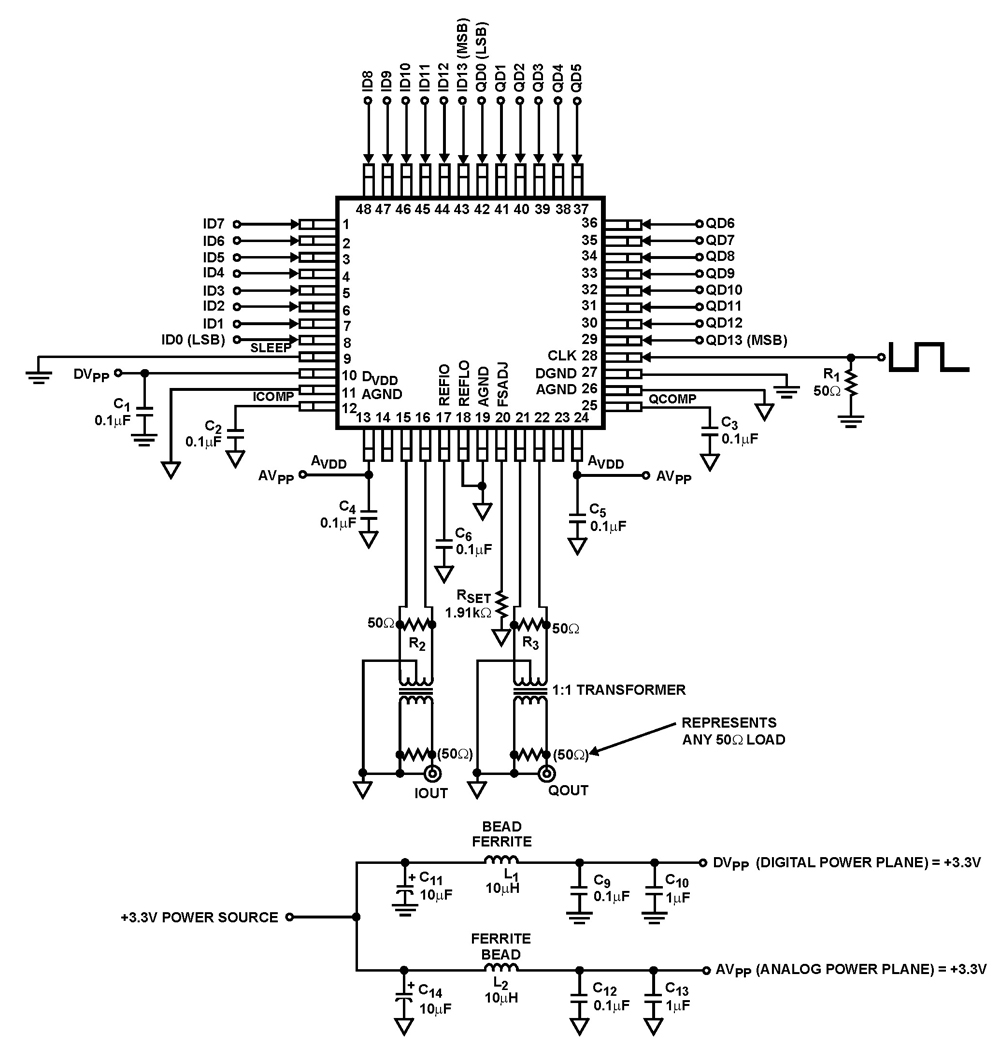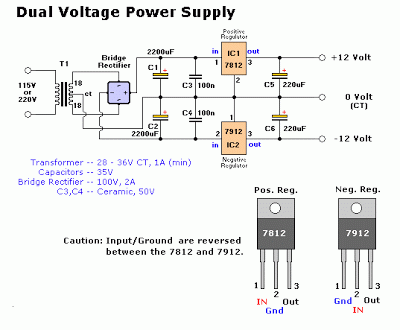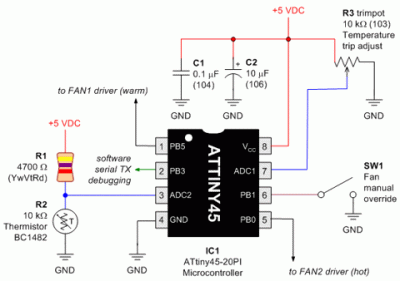
Dual tone decoding
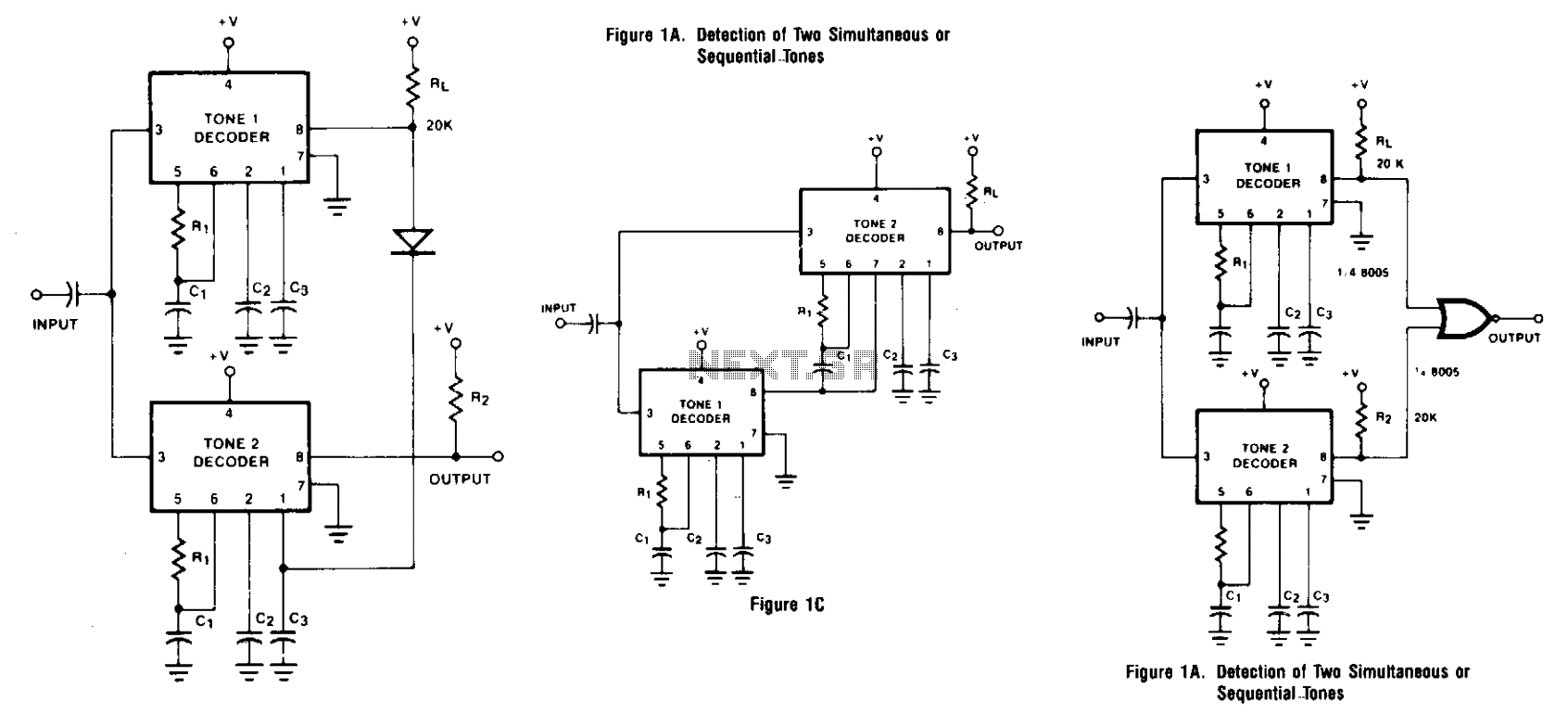
Two integrated tone decoders, XR-567 units, can be connected to allow for the decoding of simultaneous or sequential tones. Both units must be activated before an output is produced. Resistors R1 and R'1, along with capacitors C1 and C'1, are selected for Tones 1 and 2, respectively. For decoding sequential tones (Tone 1 followed by Tone 2), capacitor C3 should be significantly large to delay the turn-off of Unit 1 until Unit 2 has been activated, thus enabling the NOR gate. It is important to note that the incorrect sequence (Tone 2 followed by Tone 1) will not yield an output since Unit 2 will deactivate before Unit 1 activates. Figure 1B illustrates a circuit variation that removes the NOR gate. In this configuration, the output is derived from Unit 2, but the output stage of Unit 2 is biased off by resistor R2 and diode CR1 until it is triggered by Tone 1. An additional variation is depicted in Figure 1C. In this setup, Unit 2 is activated by the output from Unit 1 when Tone 1 is detected, effectively halving the standby power consumption. Consequently, when Unit 2 is active, Tone 1 is either currently present or was recently detected. If Tone 2 is subsequently detected, Unit 2 will also activate, resulting in an output. Due to the possibility of a transient output pulse occurring when Unit 1 is activated, even in the absence of Tone 2, the load must have a slow response to prevent a false output from being triggered by Tone 1 alone. The XR-267 Dual Tone Decoder can serve as a replacement for two integrated tone decoders in this application.
The XR-567 tone decoder circuit is designed for flexibility in decoding tones, allowing for both simultaneous and sequential tone detection. The operation hinges on the proper selection of passive components, specifically resistors and capacitors, which influence the timing and response characteristics of each unit. The interconnected configuration of the two XR-567 units ensures that both must be operational to generate a valid output signal.
The use of a large capacitor (C3) for delaying the turn-off of Unit 1 is critical in applications where sequential tone detection is required. This delay mechanism ensures that Unit 1 remains active long enough for Unit 2 to detect Tone 2, thus preventing premature deactivation that would otherwise inhibit the output signal. The NOR gate's role in the original design is to provide a logic function that only allows output when both tones are detected in the correct order.
In the variation shown in Figure 1B, the removal of the NOR gate simplifies the circuit while still maintaining functionality. The biasing of Unit 2's output stage ensures that it remains inactive until Tone 1 is detected, at which point the circuit becomes responsive to the presence of Tone 2.
The further modification illustrated in Figure 1C introduces a more efficient operational mode by linking the activation of Unit 2 directly to the output of Unit 1. This configuration not only reduces power consumption but also enhances the responsiveness of the circuit to Tone 2, as Unit 2 will only activate if Tone 1 has been detected first.
In applications where transient responses could lead to false outputs, careful consideration must be given to the load characteristics. The load should exhibit a slow response to mitigate the risk of detecting spurious signals from the activation of Unit 1 alone. The XR-267 Dual Tone Decoder offers a compact solution that integrates the functionality of the two XR-567 units, providing a streamlined alternative for tone detection applications.Two integrated tone decoders, XR-567 units, can be connected (as shown in Fig. 1A) to permit decoding of simultaneous or sequential tones. Both units must be on before an output is given. R1C1 and R'IC'l are chosen, respectively, for Tones 1 and 2. If sequential tones (1 followed by 2) are to be decoded, then C3 is made very large to delay turn-off of Unit 1 until Unit 2 has turned on and the NOR gate is activated. Note that the wrong sequence (2 followed by 1) will not provide an output since Unit 2 will turn off before Unit 1 comes on.
Figure IB shows a circuit variation which eliminates the NOR gate. The output is taken from Unit 2, but the Unit 2 output stage is biased off by R2 and CR1 until activated by Tone 1. A further variation is given in Fig. IC. Here, Unit 2 is turned on by the Unit 1 output when Tone 1 appears, reducing the standby power to half. Thus, when Unit 2 is on, Tone 1 is or was present. If Tone 2 is now present, Unit 2 comes on also and an output is given. Since a transient output pulse may appear at Unit 1 turn-on, even if Tone 2 is not present, the load must be slow in response to avoid a false output due to Tone 1 alone.
The XR-267 Dual Tone Decoder can replace two integrated tone decoders in this application. 🔗 External reference
The XR-567 tone decoder circuit is designed for flexibility in decoding tones, allowing for both simultaneous and sequential tone detection. The operation hinges on the proper selection of passive components, specifically resistors and capacitors, which influence the timing and response characteristics of each unit. The interconnected configuration of the two XR-567 units ensures that both must be operational to generate a valid output signal.
The use of a large capacitor (C3) for delaying the turn-off of Unit 1 is critical in applications where sequential tone detection is required. This delay mechanism ensures that Unit 1 remains active long enough for Unit 2 to detect Tone 2, thus preventing premature deactivation that would otherwise inhibit the output signal. The NOR gate's role in the original design is to provide a logic function that only allows output when both tones are detected in the correct order.
In the variation shown in Figure 1B, the removal of the NOR gate simplifies the circuit while still maintaining functionality. The biasing of Unit 2's output stage ensures that it remains inactive until Tone 1 is detected, at which point the circuit becomes responsive to the presence of Tone 2.
The further modification illustrated in Figure 1C introduces a more efficient operational mode by linking the activation of Unit 2 directly to the output of Unit 1. This configuration not only reduces power consumption but also enhances the responsiveness of the circuit to Tone 2, as Unit 2 will only activate if Tone 1 has been detected first.
In applications where transient responses could lead to false outputs, careful consideration must be given to the load characteristics. The load should exhibit a slow response to mitigate the risk of detecting spurious signals from the activation of Unit 1 alone. The XR-267 Dual Tone Decoder offers a compact solution that integrates the functionality of the two XR-567 units, providing a streamlined alternative for tone detection applications.Two integrated tone decoders, XR-567 units, can be connected (as shown in Fig. 1A) to permit decoding of simultaneous or sequential tones. Both units must be on before an output is given. R1C1 and R'IC'l are chosen, respectively, for Tones 1 and 2. If sequential tones (1 followed by 2) are to be decoded, then C3 is made very large to delay turn-off of Unit 1 until Unit 2 has turned on and the NOR gate is activated. Note that the wrong sequence (2 followed by 1) will not provide an output since Unit 2 will turn off before Unit 1 comes on.
Figure IB shows a circuit variation which eliminates the NOR gate. The output is taken from Unit 2, but the Unit 2 output stage is biased off by R2 and CR1 until activated by Tone 1. A further variation is given in Fig. IC. Here, Unit 2 is turned on by the Unit 1 output when Tone 1 appears, reducing the standby power to half. Thus, when Unit 2 is on, Tone 1 is or was present. If Tone 2 is now present, Unit 2 comes on also and an output is given. Since a transient output pulse may appear at Unit 1 turn-on, even if Tone 2 is not present, the load must be slow in response to avoid a false output due to Tone 1 alone.
The XR-267 Dual Tone Decoder can replace two integrated tone decoders in this application. 🔗 External reference
